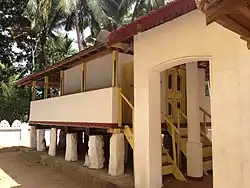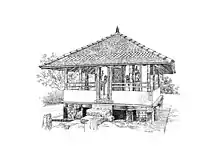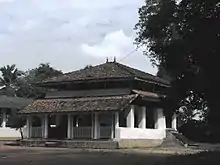Tempita Vihara
Tempita Vihara (Sinhala: ටැම්පිට විහාර) is a unique type of image house found in some Buddhist temples in Sri Lanka. Have an inimitable architecture design, Tempita Viharas were popular aspect of many Buddhist temples during the 17th-19th centuries.[1] Construction of Tempita Vihara in or after the 20 century has been not recorded.[2] There are more than two hundred Tempita Viharas have been identified in Sri Lanka to date.[3] Most of the shrines are found in North Western, Sabaragamuwa, Central and Western provinces.


Medawala Tempita Vihara in Kandy is considered the first accounted Tempita Vihara in Sri Lanka.[2] According to the Medawala copper plaque, it was a two storied shrine during the 14 century and was renovated as a Tempita Vihara by Kirti Sri Rajasinha (1747 - 1781) in 1755. Minuwangamuwa Tempita Vihara in Kegalle is believed to be the last Tempita Vihara in the island built on 2 May 1886.[2]
Beside the Buddhist temples, few Ambalamas and Devalayas have been identified in Sri Lanka as Tempita buildings. These structures are also built on raised stone pillars or rock boulders but have minor differences in its architecture design. Awariyawala Ambalama in Gampaha, Panawitiya Ambalama in Kurunegala and Halpe Pattini Devalaya in Ella are three examples of them.
The structure
Perched on raised stone pillars or stumps, Tempita Viharas possess wooden platforms and wattle walls supporting a timber framed roof.[4] Usually pillars are in exposed state and not more than 3 or 4 feet in height. However the pillars used in some temples such as Dodamthale Raja Maha Vihara in Mawanella and Ambulugala Raja Maha Vihara are about 6 feet in height.[5] Wattle walls make the main enclosed shrine room containing the Buddha statues made of Limestones or timber. Inner walls are usually decorated with varies murals and paintings of the Kandyan period. The roofs are two-pitched and covered with flat clay tiles. Some Tempita Viharas have narrow verandas circulating the main enclosed space.[4]
Secondary Feature Constructions

Initially being built as an image house, the ‘tempita vihara[6]’ seems to have taken some time to depart from its main utilities. Apart from the Ihala Kadigamuwa Pushparama Tempita Viharaya, that gained recognition as the ‘Tempita Pothgula’ (library) and the ‘Saddarma Poth Gabadava’ (Saddarma Book Store), since the main need for the construction of all the others was an image house; other features were added to their utilities at a higher point of cultural temple centric development.
There is a wall surrounding the high-pillared ground floor of the ‘tempita vihara’ [6] which embeds the pillars. This being a construction of a later period, it suggests that the ground floor had been made use of as a ‘bana maduwa’ (sermon hall) and a ‘pohoya seema’ (Chapter house). Doragamuwa and Diyasunnata are such examples.
The other is the ‘digge’ (dancing/audience hall) or ‘hewisi mandapa’ (drummers’ hall) built towards the front of the ‘tempita vihara’ and joined to the front slope of the roof. While this feature is evident in the majority of the ‘tempita viharas’, its structural enhancements include arches, wooden pillars and the presence and absence of short walls.
While Omalpe is a ‘tempita vihara’ which include both the aforesaid secondary features of construction, it also has the longest ‘digge’ as well.
Moreover, a large proportioned meditation hall has been constructed and joined with the roof of the tempita vihara’s sermon hall by means of a storm gutter, thus creating a new structure. The entrance to the ‘tempita vihara’ is through the sermon hall and when the twin doors are opened, the Buddha image within the ‘tempita vihara’ is clearly visible to the audience in the sermon hall.
The ‘tam’ or base pillars which are the identity of a ‘tempita vihara’ being covered up during later renovations were a not-so-rare and rare experience during the research. When thus covered, in appearance it becomes a temple built on a normal foundation. Though through the features of the inner chambers views could be expressed under the assumption that it is a ‘tempita vihara’, the uniqueness of the construction has been lost in the process. The ‘tempita viharas’ at Asmadala, Bodhimalkada and Udatalavinna, thus renovated in recent history are examples that could be proved.
While all these are structural features based upon the monastic and social necessities of the times, this paved the way for main shapes of the ‘tempita vihara’ to take on different shapes.
Kirielle and Kadigamuwa[6]
They are Kadigamuwa and Kirielle. At Kadigamuwa two ‘tempita viharas’ have been constructed vertically during the past 100 years or so, at the Nadun Viharaya in Kirielle two have been constructed horizontally abutting each other. At the twin ‘tempita viharas’ in Kirielle, the base pillars have been covered up during later renovations, while their structural appearances and paintings exhibit a Sabaragamuwa identity in a mixed feature of the Kandyan Era and the Southern traditions, thus forming a valuable creation of art. While the nearby new temple constructed horizontally exhibits the features of the cultural progress of the times; for a person studying the arts or socio-monastic progress, the first ‘tempita vihara’ could be considered a special milestone in the study of the art of temple complexes from their inception to the present.
Kadigamuwa too exhibits the heritage of a similar series of constructions as two vertical ‘tempita viharas’ and a new temple while they have been constructed in a row behind the ancient Bo tree. At Kirielle, all the openings face the Bo tree.
Various constructions have been carried out within Kadigamuwa with the direct and indirect sponsorships of King Valagamba to King Keerthi Sri Rajasinghe. Since it has been constructed alongside the road to the kingdom via Balana, it has undergone various transformations due to many a socio-cultural factors. The entire temple complex stands proudly while featuring the core of all Sri Lankan arts.
The Nadun Viharaya too has been constructed under royal sponsorship in 1801 within a ‘nindagama’ (villages gifted to officers for royal services) gifted by the Dumbara Maha Nilame (high ranking officer in the services of royalty) on his written order on a small palm leaf umbrella. While history bears witness that this was gifted to Venerable Karandana Devarakkita Unnanse for the temple to be built, it is said that this ‘nindagama’ is 8,305 acres in extent. While it is no secret that the ‘nindagama’ became a treasury of wealth due to the presence of graphite and rubber, the significance of this ‘nindagama’ could be realized from the study of these troika of temples under the Nadun Viharaya.
These contemporarily built temples are similar while being constructed as the first tempita vaharaya, the second tempita viharaya and the new temple. These two temples constructed alongside the ancient road to the kingdom from the South of Sri Lanka geographically belong to Sabaragamuwa and the central Provinces. Hence, for over a century this troika of temples has carried the artistic features unique to each region and these have been properly established within structurally similar tempita viharas.
The identities of each particular era are clearly evident within these structures created through a fine mixture of factors like economic strength, sponsorship and guidance. While the same viharaya undergoing timely modifications is a common experience, this image house which is outside of this added living data towards a new direction for this research.
Soldara Vihara (Storied Temples)[7]
This could be called a unique set encountered during the research into tempita viharas. The Mahalloluwa and Dodantale classified and identified as tempita viharas by the Department of Archaeology (Gamini Wijesuriya) too belong to this set. While the literal term ‘soldara vihara’[7] (storied temples) is practiced within the glossary of Mawanella and Kegalle in identify these, I introduce this to the research through the same.

‘Soldara Viharas’[7] are seven in number. They are the Mahalloluwa, Attanagoda, Dodantale, Gallengolla, Keraminiya,keselwatta and Ketapitiya.
Among these, except Ketapitiya, all the others are located on the right side of the Kandy Road (while travelling from Colombo to Kandy) and in close proximity to the old Kandy Road connecting Sabaragamuwa. Poththapitiya, with its unique architectural creations amidst the Ketapitiya Raja Maha Viharaya (ancient temple) and several other temples is located at the Ketapitiya junction along the Kadugannawa road. The soldara vihara constructed within a special geographic region with special architectural features is a wonderful architectural creation.
These temples rising upward with the wooden floor on high arches as the ground are magnificent in appearance; spacious and are rectangular in shape. While the upper floor with the Buddha image is also spacious, it has a four faceted roof of the Kandyan Era or a twin-skewed four faceted roof.
While storied houses of nobles within the social systems of the times are found island-wide, they are a common component as architectural creations. The name ‘Soldara Vihara’ (storied temples) may have come into public practice since these temples had been built with their ground and upper floors occupying large spaces similar to that for a house. Dodantale is the most ancient among the Soldara Viharas[7] while Mahalloluwa and Gallengolla could be considered the most recently built.
Temples
| Province | District | Temples |
|---|---|---|
| Central Province | Kandy | |
| Matale | ||
| Nuwara Eliya | ||
| North Central Province | Anuradhapura | |
| Polonnaruwa | ||
| North Western Province | Puttalam | |
| Kurunegala |
| |
| Sabaragamuwa Province | Kegalle |
|
| Ratnapura | ||
| Southern Province | Galle | |
| Hambantota |
| |
| Matara | ||
| Western Province | Colombo | |
| Gampaha[45] |
| |
| Kalutara |
| |
| Uva Province | Badulla | |
| Monaragala | ||
References
- "මැදවල ටැම්පිට විහාරය". ICT Branch, Ministry of Education, Sri Lanka. Retrieved 29 September 2017.
- "ජනප්රිය කලාවෙන් උපන් ටැම්පිට විහාර". Divaina. Upali Newspapers. 21 October 2009. Retrieved 29 September 2017.
- "President directs tampita vihara conservation". President's Media Division. Presidential Secretariat of Sri Lanka. 13 October 2017. Retrieved 14 October 2017.
- "From Tempita Vihara To Hatara-Endi-Ge: The Gentile Architecture Of Rural Lanka". The architect. 2013. Retrieved 29 September 2017.
- "ටැම්පිට විහාර සම්ප්රදාය". Divaina. Upali Newspapers. 14 September 2016. Retrieved 29 September 2017.
- Dissanayaka, Ganga Rajinee (2017). ‘බෞද්ධ විහාරාංග සම්ප්රදායේ උඩරට කලාගාරය’ ‘ශ්රී ලංකාවේ ටැම්පිට විහාර’ ඉතිහාසය, සම්ප්රදාය හා විකාශය. University of Kelaniya. p. 4.
- Dissanayaka, Ganga Rajinee (2016). "Soldara Viharayas: Hybrid architecture of the Upcountry". Evolving Traditions of the Buddhist Image House (විහාරගෙය). p. 132.
- Gazette 1553 & 6 June 2008, p. 526.
- Gazette 1612 & 24 July 2009, p. 1022.
- Gazette 1723 & 9 September 2011, p. 682.
- Gazette 1586 & 23 January 2009, p. 109.
- "Gazette". The Gazette of the Democratic Socialist Republic of Sri Lanka. 948. 1 November 1996.
- Gazette 1586 & 23 January 2009, p. 111.
- Gazette 1486 & 23 February 2007, p. 13.
- Gazette 1553 & 6 June 2008, p. 534.
- Gazette 1739 & 30 December 2011, p. 1093.
- Gazette 1586 & 23 January 2009, p. 107.
- Gazette 1486 & 23 February 2007.
- Gazette 1553 & 6 June 2008, p. 532.
- "Gazette". The Gazette of the Democratic Socialist Republic of Sri Lanka. 1195. 27 July 2001.
- "Gazette". The Gazette of the Democratic Socialist Republic of Sri Lanka. 14737. 23 February 1967.
- "Gazette". The Gazette of the Democratic Socialist Republic of Sri Lanka. 139. 22 November 1974.
- "Gazette". The Gazette of the Democratic Socialist Republic of Sri Lanka. 1214. 7 December 2001.
- "Gazette". The Gazette of the Democratic Socialist Republic of Sri Lanka. 14708. 12 August 1966.
- Gazette 1586 & 23 January 2009, p. 106.
- Gazette 1486 & 23 February 2007, p. 8.
- "Gazette". The Gazette of the Democratic Socialist Republic of Sri Lanka. 1264. 22 November 2002.
- Gazette 1612 & 24 July 2009, p. 1023.
- Gazette 1612 & 24 July 2009, p. 1024.
- "Gazette". The Gazette of the Democratic Socialist Republic of Sri Lanka. 10–259. 11 October 1974.
- "Gazette". The Gazette of the Democratic Socialist Republic of Sri Lanka. 14749. 19 May 1967.
- "Gazette". The Gazette of the Democratic Socialist Republic of Sri Lanka. 86. 25 April 1980.
- Gazette 1505 & 6 July 2007, p. 9.
- Gazette 1612 & 24 July 2009, p. 1025.
- Gazette 1677 & 21 October 2010, p. 1749.
- "Gazette". The Gazette of the Democratic Socialist Republic of Sri Lanka. 1401. 8 July 2005.
- "Gazette". The Gazette of the Democratic Socialist Republic of Sri Lanka. 397. 28 January 1977.
- Gazette 1612 & 24 July 2009, p. 1021.
- "Gazette". The Gazette of the Democratic Socialist Republic of Sri Lanka. 14747. 5 May 1967.
- Gazette 1505 & 6 July 2007, p. 11.
- Gazette 1723 & 9 September 2011, p. 75.
- Gazette 1553 & 6 June 2008, p. 527.
- "Gazette". The Gazette of the Democratic Socialist Republic of Sri Lanka. 61. 2 November 1958.
- Gazette 1553 & 6 June 2008, p. 523.
- "අස්වැන්නෙහි ආරක්ෂකයා වූ ගම්පහ ටැම්පිට විහාර". Divaina. Upali Newspapers. 21 September 2011. Retrieved 29 September 2017.
- Gazette 1586 & 23 January 2009, p. 104.
- Gazette 1553 & 6 June 2008, p. 529.
- ‘බෞද්ධ විහාරාංග සම්ප්රදායේ උඩරට කලාගාරය’ ‘ශ්රී ලංකාවේ ටැම්පිට විහාර’ Samkathana Research Center & Archive, University of Kelaniya
- අපේ උරුමකම 01 කොටස (2016.01.19)
- අපේ උරුමකම - 02 කොටස (2016.01.19)
- අපේ උරුමකම - 03 කොටස (2016.01.19)
- Artistic traditions in 'Temples on Pillars' (Tämpita Vihāras) of Sri Lanka Evolving Traditions of the Buddhist Image House (විහාරගෙය) Understanding two centuries of art and architecture in Sri Lanka- Part I Ganga Rajinee Dissanayaka
External links
- "PART I : SECTION (I) — GENERAL Government Notifications" (PDF). The Gazette of the Democratic Socialist Republic of Sri Lanka. 1486. 23 February 2007.
- "PART I : SECTION (I) — GENERAL Government Notifications" (PDF). The Gazette of the Democratic Socialist Republic of Sri Lanka. 1505. 6 July 2007.
- "PART I : SECTION (I) — GENERAL Government Notifications" (PDF). The Gazette of the Democratic Socialist Republic of Sri Lanka. 1553. 6 June 2008.
- "PART I : SECTION (I) — GENERAL Government Notifications" (PDF). The Gazette of the Democratic Socialist Republic of Sri Lanka. 1586. 23 January 2009.
- "PART I : SECTION (I) — GENERAL Government Notifications" (PDF). The Gazette of the Democratic Socialist Republic of Sri Lanka. 1612. 24 July 2009.
- "PART I : SECTION (I) — GENERAL Government Notifications" (PDF). The Gazette of the Democratic Socialist Republic of Sri Lanka. 1677. 22 October 2010.
- "PART I : SECTION (I) — GENERAL Government Notifications" (PDF). The Gazette of the Democratic Socialist Republic of Sri Lanka. 1723. 9 September 2011.
- "PART I : SECTION (I) — GENERAL Government Notifications" (PDF). The Gazette of the Democratic Socialist Republic of Sri Lanka. 1739. 30 December 2011.
